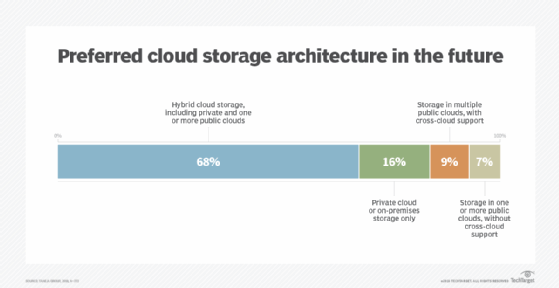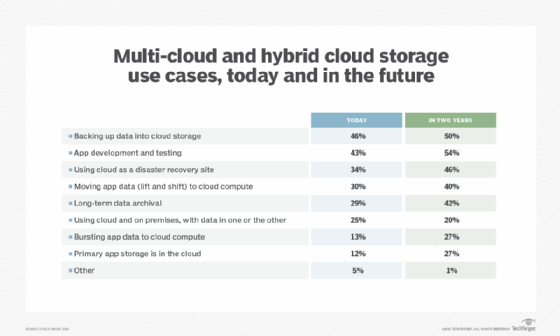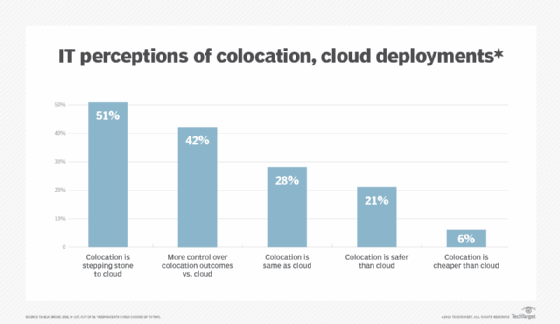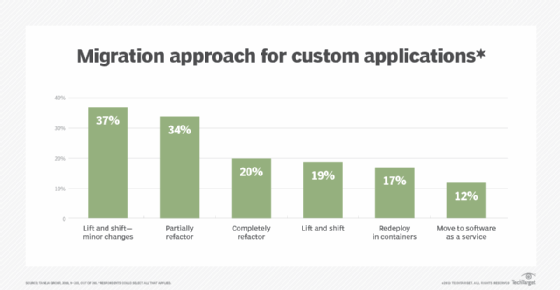Storage
- Editor's letterWhen converged and hyper-converged -- and cloud -- converge
- Cover storyMachine learning for data analytics can solve big data storage issues
- InfographicThe realities of unstructured data management revealed
- FeatureProtect backups from ransomware and other security risks
- ColumnLarger, expandable HCI nodes bring big infrastructure benefits
- ColumnSupport for production-level hybrid cloud use cases on the rise

Support for production-level hybrid cloud use cases on the rise
A recent Taneja Group survey reveals that hybrid cloud and multi-cloud are the preferred cloud storage architectures for a variety of enterprise storage use cases.
When it comes to the architecture IT leaders are betting on, hybrid cloud is the clear choice. In a recent Taneja Group survey of 370 end-user organizations, two-thirds of respondents indicated that hybrid cloud is their architecture for the future.
For most, this vision for hybrid cloud use cases includes deploying workloads to multiple public clouds in addition to maintaining an on-premises footprint most often for core business-critical apps. The on-premises data center of tomorrow may shrink, but for an overwhelming majority of companies it will be complemented increasingly by a cloud component.
The first figure below shows the overall response to the survey. Only one out of six companies favor a public cloud-only approach, while a similar percent plan to keep their workloads solely on premises.
Hybrid cloud use cases expand from secondary to primary
Based on Taneja's research, nearly all companies have some primary storage in one or more public clouds, with a majority of respondents having two or more clouds. AWS and Azure dominate the provision of storage for supporting cloud-native and traditional packaged apps.
But enterprise storage strategies are pivoting not just to multi-cloud, but to hybrid multi-cloud, enabling a full choice of where to deploy business apps and support primary storage.
Secondary data use cases such as backup, archive and disaster recovery, along with test/dev, dominate. But the mix will shift significantly in the years ahead. What types of hybrid cloud use cases are companies deploying or planning to deploy for storage?
As the results in the second figure illustrate, secondary data use cases will continue to migrate to the cloud. But primary data use cases will also increase in importance.
In the next two years, four out of 10 companies plan to lift and shift at least some of their application data to cloud compute, an increase of more than 30%. Even more compelling, 27% of respondents plan to move at least some of their primary application storage to the cloud, a greater than two-times increase over current deployments.

IT decision-makers have progressively gained more confidence in public cloud infrastructure, paving the way for more serious storage deployments there. Data security, compliance and portability concerns were huge roadblocks to public cloud storage deployments as recently as three or four years ago. But many companies now find those challenges more manageable as the number of storage proof points for multi-cloud and hybrid cloud use cases continues to grow and public cloud providers build more enterprise capabilities into their offerings.
Hybrid cloud use cases and the rise of colos
For those organizations not yet ready to move their storage to the public cloud, deploying in a colocation (colo) facility can be a good first step toward enabling a public and hybrid cloud deployment.
For example, enterprises can connect primary storage in a colo via high-speed pipes to business apps running in one or more public clouds. Public cloud providers often have a point of presence at the same colo facility, further facilitating high-performance access. This approach enables IT to maintain greater control over storage infrastructure, while still fulfilling top-down mandates to move workloads to the cloud.

As shown in the next figure, 42% of those surveyed like that colo deployments give them more control. Viewing colos much like an extension of their own data centers, more than 50% of respondents see them as a solid initial step in the journey to hybrid cloud.
Dell EMC, Hewlett Packard Enterprise and NetApp all provide colo storage offerings, with Dell EMC offering diversified Cloud Storage Services to enable customers to take advantage of public cloud storage economics and agility for business workloads running on premises.
For example, to enable multi-cloud access for data recovery using these colo offerings, data is natively replicated from on premises to an array in the colo facility, which is directly connected using high-speed pipes to disaster recovery storage in one or more public clouds.

Portability remains a sticking point
Portability can be a challenge, not just for data but for the apps themselves. Many IT professionals would like to deploy more production business apps directly in a public or hybrid cloud environment, but often find it difficult and costly to move those apps to the cloud.
While organizations can move web-tier apps relatively easily, complex production apps interconnected with or dependent on other apps -- or built using legacy coding techniques or languages -- are much more difficult to adapt and migrate to the cloud.
As illustrated in the final figure, when it comes to moving custom business apps to the cloud, some degree of refactoring or rearchitecting is usually required. Though many application owners would prefer to simply redeploy their apps in containers or move to a software-as-a-service-based approach, those approaches are often quite difficult, if not impossible, for custom legacy applications.
Refactoring can be costly and time-consuming, but once done can enable workloads to take advantage of cloud benefits such as availability zones for improved compliance and proximity to users and pay-as-you-go access. Internal IT, cloud or application development teams typically take the lead in the migration effort, with system integrators or IT consultants often playing an advisory or supporting role.

Takeaways for your organization
What do these research insights into public, multi-cloud and hybrid cloud use cases mean for your organization? If you're not running at least some secondary data workloads in the cloud, you're in the minority. And unless your internal policies or industry regulations prevent it, you should ramp up your use of the cloud for backup, archiving and disaster recovery to take advantage of cloud agility and economics.
Beyond that, think about how the public or hybrid cloud can benefit selected primary apps and the data that supports them. If your organization is not driven by a cloud-first mandate, in which all new apps are -- by default -- developed in the cloud based on a microservices architecture, you should still consider following a cloud-appropriate approach. Start by thinking about which of your new and existing apps will benefit from being born in or moved to the cloud.


























